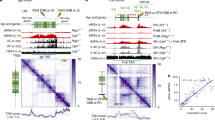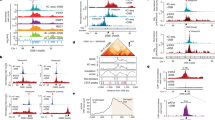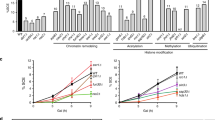Abstract
The repair of DNA double-strand breaks (DSBs) is crucial for maintaining genome stability. Eukaryotic cells repair DSBs by both non-homologous end joining and homologous recombination. How chromatin structure is altered in response to DSBs and how such alterations influence DSB repair processes are important issues. In vertebrates, phosphorylation of the histone variant H2A.X occurs rapidly after DSB formation1, spreads over megabase chromatin domains, and is required for stable accumulation of repair proteins at damage foci2. In Saccharomyces cerevisiae, phosphorylation of the two principal H2A species is also signalled by DSB formation, which spreads ∼40 kb in either direction from the DSB3. Here we show that near a DSB phosphorylation of H2A is followed by loss of histones H2B and H3 and increased sensitivity of chromatin to digestion by micrococcal nuclease; however, phosphorylation of H2A and nucleosome loss occur independently. The DNA damage sensor MRX4 is required for histone loss, which also depends on INO80, a nucleosome remodelling complex5. The repair protein Rad51 (ref. 6) shows delayed recruitment to DSBs in the absence of histone loss, suggesting that MRX-dependent nucleosome remodelling regulates the accessibility of factors directly involved in DNA repair by homologous recombination. Thus, MRX may regulate two pathways of chromatin changes: nucleosome displacement for efficient recruitment of homologous recombination proteins; and phosphorylation of H2A, which modulates checkpoint responses to DNA damage2.
This is a preview of subscription content, access via your institution
Access options
Subscribe to this journal
Receive 51 print issues and online access
$199.00 per year
only $3.90 per issue
Buy this article
- Purchase on Springer Link
- Instant access to full article PDF
Prices may be subject to local taxes which are calculated during checkout




Similar content being viewed by others
References
Rogakou, E. P., Pilch, D. R., Orr, A. H., Ivanova, V. S. & Bonner, W. M. DNA double-stranded breaks induce histone H2AX phosphorylation on serine 139. J. Biol. Chem. 273, 5858–5868 (1998)
Arkady, C. et al. Histone H2AX phosphorylation is dispensable for the initial recognition of DNA breaks. Nature Cell Biol. 5, 675–679 (2003)
Shroff, R. et al. Distribution and dynamics of chromatin modification induced by a defined DNA double-strand break. Curr. Biol. 14, 1703–1711 (2004)
Usui, T., Ogawa, H. & Petrini, J. H. A DNA damage response pathway controlled by Tel1 and the Mre11 complex. Mol. Cell 7, 1255–1266 (2001)
Shen, X., Mizuguchi, G., Hamiche, A. & Wu, C. A chromatin remodelling complex involved in transcription and DNA processing. Nature 406, 541–544 (2000)
Sugawara, N., Wang, X. & Haber, J. E. In vivo roles of Rad52, Rad54, and Rad55 proteins in Rad51-mediated recombination. Mol. Cell 12, 209–219 (2003)
Lee, S. E. et al. Saccharomyces Ku70, Mre11/Rad50 and RPA proteins regulate adaptation to G2/M arrest after DNA damage. Cell 94, 399–409 (1998)
Downs, J. A., Lowndes, N. F. & Jackson, S. P. A role for Saccharomyces cerevisiae histone H2A in DNA repair. Nature 408, 1001–1004 (2000)
Weiss, K. & Simpson, R. T. High-resolution structural analysis of chromatin at specific loci: Saccharomyces cerevisiae silent mating type locus HMLα. Mol. Cell. Biol. 18, 5392–5403 (1998)
Reinke, H. & Horz, W. Histones are first hyperacetylated and then lose contact with the activated PHO5 promoter. Mol. Cell 11, 1599–1607 (2003)
Kristjuhan, A. & Svejstrup, J. Q. Evidence for distinct mechanisms facilitating transcript elongation through chromatin in vivo. EMBO J. 23, 4243–4252 (2004)
Schwabish, M. A. & Struhl, K. Evidence for eviction and rapid deposition of histones upon transcriptional elongation by RNA polymerase II. Mol. Cell. Biol. 24, 10111–10117 (2004)
Uziel, T. et al. Requirement of the MRN complex for ATM activation by DNA damage. EMBO J. 22, 5612–5621 (2003)
Lisby, M., Barlow, J. H., Burgess, R. C. & Rothstein, R. Choreography of the DNA damage response: spatiotemporal relationships among checkpoint and repair proteins. Cell 118, 699–713 (2004)
Shen, X., Ranallo, R., Choi, E. & Wu, C. Involvement of actin-related proteins in ATP-dependent chromatin remodeling. Mol. Cell 12, 147–155 (2003)
Morrison, A. J. et al. INO80 and γ-H2AX interaction links ATP-dependent chromatin remodeling to DNA damage repair. Cell 119, 767–775 (2004)
van Attikum, H., Fritsch, O., Hohn, B. & Gasser, S. M. Recruitment of the INO80 complex by H2A phosphorylation links ATP-dependent chromatin remodeling with DNA double-strand break repair. Cell 119, 777–788 (2004)
Downs, J. A. et al. Binding of chromatin-modifying activities to phosphorylated histone H2A at DNA damage sites. Mol. Cell 16, 979–990 (2004)
Frank-Vaillant, M. & Marcand, S. Transient stability of DNA ends allows nonhomologous end joining to precede homologous recombination. Mol. Cell 10, 1189–1199 (2002)
Palter, K. B., Foe, V. E. & Alberts, B. M. Evidence for the formation of nucleosome-like histone complexes on single-stranded DNA. Cell 18, 451–467 (1979)
Mizuguchi, G. et al. ATP-driven exchange of histone H2AZ variant catalyzed by SWR1 chromatin remodeling complex. Science 303, 343–348 (2004)
Wang, X. & Haber, J. E. Role of Saccharomyces single-stranded DNA-binding protein RPA in the strand invasion step of double-strand break repair. PLoS Biol. 2, 0104–0112 (2004)
Kantake, N., Sugiyama, T., Kolodner, R. D. & Kowalczykowski, S. C. The recombination-deficient mutant RPA (rfa1-t11) is displaced slowly from single-stranded DNA by Rad51 protein. J. Biol. Chem. 278, 23410–23417 (2003)
Unal, E. et al. DNA damage response pathway uses histone modification to assemble a double-strand break-specific cohesin domain. Mol. Cell 16, 991–1002 (2004)
Chai, B., Huang, J., Cairns, B. & Laurent, B. C. Distinct roles for the Rsc and Swi/Snf ATP-dependent chromatin remodelers in DNA double-strand break repair. Genes Dev. 19, 1656–1661 (2005)
Miyazaki, T., Bressan, D. A., Shinohara, M., Haber, J. E. & Shinohara, A. In vivo assembly and disassembly of Rad51 and Rad52 complexes during double-strand break repair. EMBO J. 23, 939–949 (2004)
Nakamura, T. M., Du, L. L., Redon, C. & Russell, P. Histone H2A phosphorylation controls Crb2 recruitment at DNA breaks, maintains checkpoint arrest, and influences DNA repair in fission yeast. Mol. Cell. Biol. 24, 6215–6230 (2004)
Kuo, M. H. & Allis, C. D. In vivo cross-linking and immunoprecipitation for studying dynamic protein:DNA associations in a chromatin environment. Methods 19, 425–433 (1999)
Lichten, W. Data and Error Analysis in the Introductory Physics Laboratory (Allyn and Bacon, Newton, MA, 1988)
Fleming, A. B. & Pennings, S. Antagonistic remodelling by Swi-Snf and Tup1-Ssn6 of an extensive chromatin region forms the background for FLO1 gene regulation. EMBO J. 20, 5219–5231 (2001)
Acknowledgements
We thank J. Haber, X. Shen, J. Downs, M. Christman and V. Zakian for strains or plasmids; W.-D. Heyer for antibodies against RPA and Rad51; C. Hillyer and N. Clark for technical assistance; and C.-F. Kao for comments. This work was supported by grants from the NIH. (to M.A.O. and to J.A.N.).
Author information
Authors and Affiliations
Corresponding author
Ethics declarations
Competing interests
Reprints and permissions information is available at npg.nature.com/reprintsandpermissions. The authors declare no competing financial interests.
Supplementary information
Supplementary Methods
Additional details of the methods used in this study (DOC 33 kb)
Supplementary Figure Legends
Legends to accompany the below Supplementary Figures. (DOC 29 kb)
Supplementary Figure 1
Densitometry traces of MNase ladders at MATα. (PDF 61 kb)
Supplementary Figure 2
MNase digestion of bulk chromatin. (PDF 554 kb)
Supplementary Figure 3
γ-H2A levels and histone eviction profiles in mre11δ and arp8δ mutants. (PDF 107 kb)
Supplementary Figure 4a
MATα DNA is cleaved and resected in an arp8δ mutant. (PDF 5895 kb)
Supplementary Figure 4b,c
MATα DNA is cleaved and resected in an arp8δ mutant. (PDF 57 kb)
Supplementary Figure 5
Role of γ-H2A in recruitment of Ino80 to the MATα DSB. (PDF 68 kb)
Supplementary Figure 6
DNA repair phenotypes of an arp8δ mutant. (PDF 130 kb)
Rights and permissions
About this article
Cite this article
Tsukuda, T., Fleming, A., Nickoloff, J. et al. Chromatin remodelling at a DNA double-strand break site in Saccharomyces cerevisiae. Nature 438, 379–383 (2005). https://doi.org/10.1038/nature04148
Received:
Accepted:
Issue Date:
DOI: https://doi.org/10.1038/nature04148
This article is cited by
-
Chidamide and venetoclax synergistically exert cytotoxicity on multiple myeloma by upregulating BIM expression
Clinical Epigenetics (2022)
-
ATP-dependent chromatin remodelers and aging
The Nucleus (2021)
-
Co-inhibition of HDAC and MLL-menin interaction targets MLL-rearranged acute myeloid leukemia cells via disruption of DNA damage checkpoint and DNA repair
Clinical Epigenetics (2019)
-
Chromatin mobility upon DNA damage: state of the art and remaining questions
Current Genetics (2019)
-
ATM and CDK2 control chromatin remodeler CSB to inhibit RIF1 in DSB repair pathway choice
Nature Communications (2017)
Comments
By submitting a comment you agree to abide by our Terms and Community Guidelines. If you find something abusive or that does not comply with our terms or guidelines please flag it as inappropriate.



